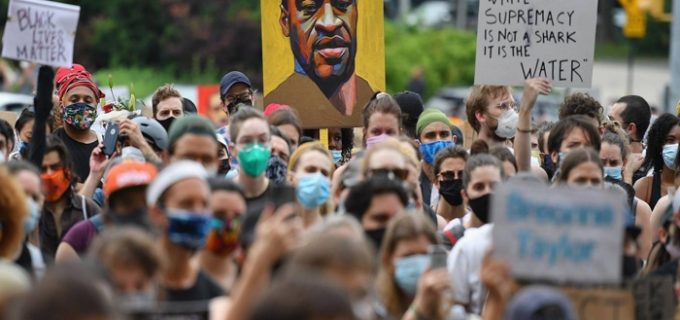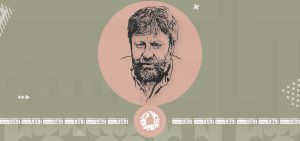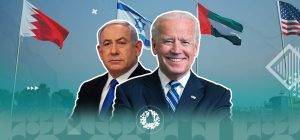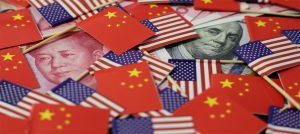Since May 25, many US cities have witnessed major protests with an unprecedented momentum. This followed the killing of US citizen George Floyd at the hands of an American officer with racist motives.
The protests spread over Minneapolis – the city in which the event occurred – and its capital state Minnesota. Similar protests also ignited in a number of central states such as Washington, New York and San Francisco, with solidarity protests erupting in several European cities and capitals, with protesters carrying slogans condemning racism and demanding justice and equality.
These events have led to an escalation in violence and destruction by elements who penetrated the anti-racism movement, according to protesters’ accounts, with violent reactions by US police claiming many lives. Although the numbers of demonstrators have begun to dwindle, the symbolism of the protests is still ongoing in various forms and with certain messages, such as the carrying of slogans demanding justice, and music and songs with relevant lyrics performed in public squares.
These protests have had a direct impact on the popularity of US President Donald Trump as a result of his contribution in entrenching racism, according to his opponents, and his handling of the protests, as well as his handling of previous relevant files. This raises a number of questions about the motives of these protests, the official responses to these protests, and the impact of all of these events on the popularity of the US president.
Motives for US protests
Black Americans make up 13% of the population, amounting to 40 million people. Despite the legal recognition of this segment of the population and the participation of many in state agencies and involvement in government jobs, they still suffer due to existential official and popular racist behaviours. George Floyd’s story was but the last fuse that ignited the protests.
1) Racism
Black Americans have been suffering racism consistently, and despite the laws legislated in the 1950s, such as the Civil Rights Act and the Racial Discrimination Act, discrimination did not end in its entirety. In 1991, US streets were engulfed in protests against the ruling of the Los Angeles Court that acquitted police officers who beat a black citizen, and in 2010, protesters came out to reject a court ruling that sentenced a policeman who killed a black citizen to only two years in prison.
A number of problems continues to face black Americans. The US unemployment report in May 2020 showed that the unemployment rate among blacks is 16.7%, and that the death rate among black Americans due to Covid-19 was more than non-blacks. The report also showed low wages for black teachers and an imbalance in the distribution of wealth, as well as the legal violations they are exposed to. Even the US President’s speech embodies a kind of racism that appears in his repeated statements, such as his statements regarding US politicians of international origin, such as Alexandria Ocasio-Cortez, Ilhan Omar and Ayanna Pressley, and his request for them to return to their country. Such comments from the Head of State contributes to the increasing racism in society. All these are indications of the extent of discrimination in US society.
Furthermore, there are a number of laws that have a negative impact on black Americans related to criminal prosecution, education, and health care. When the government adopted social insurance in 1935, it excluded agricultural workers, home workers, and daily income earners, the majority of whom were black Americans, in addition to criminal prosecution. This segment of society is three times more likely to be imprisoned than whites, and this has a direct impact on education, employment and professional development opportunities. Although apartheid is officially prohibited, on the ground it is practically present in many places. Blacks live mostly in black societies, and their health care is much worse than those in white-populated areas, as well as education and job opportunities, according to Professor Christian Lammert, a political affairs expert at the John F. Kennedy Institute at the University of Berlin.
The Covid-19 pandemic doubled the suffering experienced by this segment of society – the percentage of job losses and the rate of deaths increased, according to a study prepared by the Economic Policy Institute. Indeed, the unemployment rate among whites increased from 3.1% to 14.2%, while black unemployment jumped from 5.8% to 16.7%, with around 18% of black women losing their jobs.
2) Demanding justice and the desire for change
There is a state of congestion among Americans caused by – as some see it – the presidential failure in the face of multiple problems, such as police violations, widespread unemployment and repercussions of the Covid-19 pandemic.
Police violations against Americans is not a new phenomenon, and some violations have nothing to do with racism, which means that the desire to achieve justice is not targeting a single category of people. US police violence has led to the killing of 7,666 people between 2013-2019, with 95% of this figure dying whilst in detention in police stations. These figures are according to information gathered by the CrimeMapping website, which specialises in monitoring violent violations of local police.
Far-right white supremacists were present in the protests, whether their involvement was for private motives and a desire to exploit the wave of protests, or for public motives. Indeed, authorities of the US Federal Office of Los Angeles City (FBI) seized a number of people from the Boogaloo group on May 30 – one of the extremist right-wing groups calling for the fall of the regime. They were caught whilst preparing Molotov cocktails to use in the protests.
Official reactions and President Trump’s role
The official responses issued by US officials, especially the US President, are not very different from official Arab responses to confront protests in their respective countries, and the US’s dealings have been similar to the Arab scene in the methods of distortion and violence used.
1) Distortion
US authorities have used methods to distort the protests. Sometimes, they are accused of having saboteurs, anarchists and terrorists leading these protests, which the US President views as “riotous acts of thieves and anarchists”. Other times, they accuse these protests of being supported by foreign powers who support and finance them, according to statements by US National Security Adviser Robert O’Brien, who accused China and Russia of being behind them, with Iran being a beneficiary of what was happening, and mentioning Russian activists and external beneficiaries. O’Brien considered these countries as working to stoke violence and exploit events “to widen discord and harm American democracy”, he said.
The protests are led by, according to authorities, radical left-wing anarchists, and the antifa movement. The latter is a movement opposed to the white far-right which began its activism since the rise of the far-right with President Trump’s arrival. The movement does not have a unified leadership and is spread in the cities of the West Coast.
2) Violence
US police have used a number of methods of repression to confront the protests. These methods are not only limited to pepper spray, gas bombs and other means related to dispersing protesters, but rather to killing, arrests and imprisonment. Indeed, the US President criticised state governors and accused them of being weak in front of this movement, imploring them to use the utmost degree of force to suppress the demonstrators. He said, “You have to arrest people, track them, and put them in jail for ten years, and you’ll never see this stuff again. We are doing it in Washington DC. We’re going to do something the people haven’t seen before.”
The US President issued repeated threats to deploy the army to stop protests in American streets, but this was opposed by US Defence Secretary Mark Esper who supported the option of deploying the National Guard. Indeed, Washington witnessed helicopters hovering at low altitude over demonstrators in Washington, and Trump commented on this by saying: “The problem is not the very talented, low-flying helicopter pilots wanting to save our city, the problem is the arsonists, looters, criminals, and anarchists, wanting to destroy it (and our Country)!” The protests were directed through the deployment of the National Guard and the militarisation of the police:
– Deployment of the National Guard
In Washington DC, about 1,700 National Guard personnel were deployed, and 500 in Minneapolis, Minnesota, and in more than twenty other cities to counter the protests.
The National Guard is considered a reserve military force in support of the army, but the conditions of the army are not fulfilled, and members of these forces occupy civil and private jobs, live in their homes, and have monthly and annual training obligations. Some of the National Guard follow land forces, while some join the air force, and they account for one third of the army.
– The militarisation of the police
One of the means by which the protests were met was via the militarisation of the police, the delivery of military tools and the implementation of raids and operations that are usually the prerogative of the US Marine Corps. The UN Special Rapporteur on the Promotion and Protection of the Right to Freedom of Opinion and Expression, David Kaye, and the Special Rapporteur of the Freedom of Expression Committee Edison Lanza and the Organisation of American States (OAS), a non-governmental organisation, all sent a warning in a joint statement against the militarisation of the police, saying that, “it conflicts with the right to peaceful assembly, and limits the ability of the press to cover protests”.
The impact of the protests on the upcoming US electoral scene
The protests and their consequences have had a direct impact on the popularity of the American president, who is preparing himself to run for a second term in the presidential elections next November. Trump has been keen to deliver a message to the people that he is the guardian of law and order, but the message seems to be counter-productive due to the methods of repression he has used.
US President Donald Trump, Justice Secretary William Barr and Defence Secretary Mark Esper face charges related to the crackdown on protesters in front of the White House, as the American Civil Liberties Union (ACLU) filed a lawsuit against the US administration over the violence of the security forces against peaceful demonstrators outside the White House, accusing them of violating the basic rights guaranteed by the American Constitution.
1) Democratic investment in the cause
Political rivalries between President Trump and his opponent, Democratic presidential candidate Joe Biden, were intense, as Biden criticised the crackdown on demonstrations and said about Trump: “He tear-gassed peaceful protesters and fired rubber bullets, for a photo!” referring to Trump’s visit to St. John’s church next door to the White House; a visit which held multiple messages.
Former US President Barack Obama said about Floyd’s death: “It should not be considered normal in the USA in 2020”. Obama was the first black president of the US.
A number of Democratic Party leaders have adopted the protesters’ demands calling for reforms in the police, and Washington Mayor Muriel Bowser has exchanged sharp responses with Trump. In California, Democratic Governor Gavin Newsome said he would prevent the state’s police training agency from teaching its personnel of the ways to restrict a suspect by pressing on the carotid artery of the neck.
US House Speaker Nancy Pelosi, and other Democrats, including Senate Minority Leader Chuck Schumer and California State Senator Kamala Harris, kneeled on a knee for eight minutes 46 seconds – the time the police officer kept his knee on George Floyd’s neck – in an expression of solidarity. Furthermore, the Democrats and a number of black deputies revealed comprehensive legislations on combating racial violence by the police.
2) Some Republicans have ditched the President
Ditching President Trump was not confined to his opponents, but also included prominent leaders within the Republican Party, such as Lisa Murkowski, the Republican Senator for Alaska, who revealed that she was having trouble deciding whether to support the re-election of her party’s candidate, and said that her hesitation came after Trump’s former Defence Minister James Matisse criticised Trump saying, “He is trying to divide us!” Murkowski said, “I thought General Mattis’s words were true and honest and necessary and overdue.”
The Republican camp remained somewhat composed, and neither the events calling for the president’s trial, nor the repercussions of Covid-19 pandemic which he dealt with mockingly at first and later ignored the warnings of health experts and intelligence agencies, had an impact on his popularity, but it was the recent protests that are expected to have an impact on shaking the popularity of the man. The New York Times revealed that a number of former Republican party leaders expressed dissatisfaction with Trump’s policies, most notably: former US President George W. Bush; Republican Senator for Utah and former presidential candidate Mitt Romney; and Florida Representative Francis Rooney. These Republicans pledged to not support Trump in the upcoming presidential election because of his positions in various areas, including the suppression of protests denouncing police violence.
According to polls conducted by the Washington Post, support for Trump’s competitor Joe Biden was up by ten percent – 54% versus 44%, and the poll showed that the electorate that sided with Trump in 2016, such as women and the elderly, have abandoned him, with CNN reporting a decline in Trump’s popularity.
Conclusion
Although the momentum of the US protests has stopped, it still maintains its symbolism and timeliness, with the possibility of an upsurge in the case of authorities not upholding their promises. Such promises relate to the imposition of restrictions on the use of lethal force by the police and the prohibition of restricting or administering physical pressure on the detainee, as well as allowing victims to prosecute the police. However, all these will not eliminate the phenomenon of racial discrimination which has proven to be a chronic behaviour embedded in society on all levels.
Indeed, it is possible that the incident of George Floyd and the way it was dealt with, as well as the Trump administration’s failure to deal with the Corona pandemic, may lead to a decline in the president’s popularity in the upcoming elections. However, there are other considerations that influence the electoral scene, such as the effectiveness of pressure groups which have a major role in influencing public opinion and decision-makers. Indeed, Trump has direct influence over this bloc, as well as the wealth of Trump’s election campaign. Whilst there is a democratic consensus to push Trump out, Joe Biden being approved as a candidate for the Democrats may push supporters of other proposed candidates from the Democratic Party to not vote for him, especially since there is division within the Democratic Party. These considerations, despite their importance, may not resolve the matter for one of the candidates. There may also emerge unexpected surprises that tips the scale for one of the candidates.







